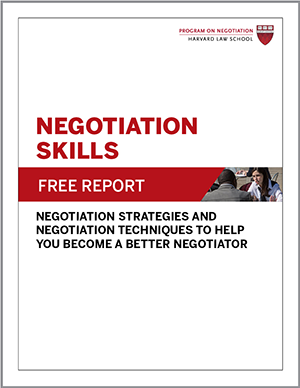
Collective bargaining negotiations help level the playing field between individual employees and management by enabling employees to organize and find strength in numbers. But when collective bargaining negotiations fall apart, the result can be a devastating strike.
To take just two examples, back in 1988, the Writers Guild of America (WGA) strike lasted five months and cost approximately $500 million in lost revenues and wages. The 1994 Major League Baseball (MLB) players’ strike led to the cancellation of the season and led owners and players to lose an estimated $1 billion in the years that followed.
Usually, disputing parties would do better to remain at the negotiating table than to head for the picket lines. Yet many negotiators fail to recognize this fact until it’s too late.
Causes of Strikes
A number of factors contribute to strikes and prevent parties from reaching agreement in collective bargaining negotiations:
- Overconfidence leads negotiators on both sides to believe their cases are stronger than they really are, while underestimating the other side’s willingness to stand firm. When one side doubts the other side’s claims, a strike becomes even more tempting.
- Fairness concerns cause negotiators to reject deals that would leave both sides better off. We sometimes are even willing to pay good money to punish those who treat us unfairly.
- Agents at the bargaining table can have incentives that are misaligned with the interests of those they represent in collective bargaining negotiations. At times, elected union representatives may be more concerned about appearing to “stand firm” than with working out a deal with management, for example.
- Viewing negotiation as a competition to be “won” keeps us focused on distributive negotiation at the expense of integrative bargaining, and stands in the way of an agreement that will satisfy everyone’s interests.
- Incremental commitment to a strike can make it difficult to end one. When the decision to “hold out for a few more days” is repeated, a strike can last for months, even years. Economists have long advised us to ignore our past investments of time, money, and other resources when making decisions about the future. Yet such “sunk costs” weigh heavily on us. The decision to cut our losses can be extremely difficult to make.
How to Defuse a Strike Using Collective Bargaining Negotiations
Strikes often end up being a waste of everyone’s time and money. To avoid or end a strike in collective bargaining negotiations, follow these five steps and enhance your negotiation skills:
- Avoid extreme demands. When talks get heated, it’s tempting to draw a line in the sand. But making firm demands is usually a mistake. When you do so, you prevent yourself from considering alternative proposals that might meet your needs just as well. To make matters worse, demands increase the tendency to escalate commitment to a strike.
- Take the other party’s perspective. Far too often in negotiation, we assume we fully understand the other side’s interests and goals. This is especially true in competitive situations such as competitive bargaining negotiations, where we tend to fall back on stereotypes. By looking for nuances in each other’s positions, we can open up opportunities to brainstorm the types of creative solutions we propose below.
- Get an outside opinion. When collective bargaining negotiations get heated, third parties can add a degree of rationality and impartiality to the proceedings. Before going on strike, seek advice from a disinterested adviser, such as an industry expert. Ask for an objective critique of your plans and encourage your expert to offer alternatives.
- Make it a “virtual” strike. In the midst of the 1994 baseball strike, Harvard Business School professors Michael Wheeler and James K. Sebenius proposed a novel solution, which unfortunately wasn’t followed: resume the MLB season, but do not allow owners and players to receive their revenues and pay. Rather, deposit these funds into an escrow fund to be disbursed only after the dispute was resolved. Presumably, the money rapidly accumulating in escrow during this “virtual strike” would motivate both sides to reach a deal. By building virtual-strike clauses into their contracts during collective bargaining negotiations, unions and management could create a situation in which strikes would not destroy long-term value to either side.
- Structure contingencies. Contingent contracts are an innovative tool for resolving negotiators’ differences of opinion about the future. When you add a contingency clause to your deal, you place a bet on how events will unfold. For example, if parties disagree about how large profits from a certain revenue stream would be, they could stipulate two different profit-sharing formulas based on their different predictions, and then see how the future plays out.
What advice would you add from your own experiences with collective bargaining negotiations?






Up close to two strikes
I would like to join the discussion about strikes. I was asked by the parties to analyze the reasons for a lengthy strike that took place in 2004 in the hotel-casino industry in Atlantic City, New Jersey. Management wanted a five-year contract to bring negotiations there in line with those in Las Vegas. The union leadership felt its Atlantic City members had become complacent and were not as energized in their support of the union as were their counterparts in Las Vegas.
It is hard to see how the strike could have been avoided. The union leadership wanted to mobilize the membership and use the pressure of a large negotiating committee to persuade management to continue the three-year contract duration. They saw picket lines and rallies as a way to build solidarity and a committed membership.
After a four-week strike and all the time and costs that build up in strike preparation, the union ended up accepting a five-year contract but also won safeguards in the contract’s outer years that would guarantee adequate company contributions to union health and welfare funds.
More recently, in 2016, I served as a mediator (along with Professor Larry Katz) in the strike by dining hall workers (also organized by UNITE HERE) against Harvard University. Harvard dining hall workers, for the most part, are laid off during the summer months when Harvard has no undergraduate students, and for years the issue of no summer pay had been looming. Management miscalculated the importance of this demand and thought that by introducing the summer compensation plan that had been put in place at Columbia University, an agreement could be reached. The union demanded a much better compensation package than the Columbia “pattern.”
Ultimately, after a three-week strike, the union won everything it had demanded.
These two strikes illustrate many of the points that have become accepted wisdom in our field; namely if management wants to win a strike it had better be willing to take a long one. That certainly describes the casino strike in Atlantic City: management endured a four-week strike, and every indication is that the hotels and casinos were prepared to hold out much longer. In the end, the union agreed to the employers’ main demand and signed a five-year agreement.
At Harvard, the union won after three weeks. Could Harvard management have won had it been willing to hold out and take all the public relations “hits” of a well-endowed university denying what the union termed “adequate compensation” for its food service workers?
Strikes have both tangible and intangible outcomes. The short strike at Harvard not only won important economic gains for the workers, but also produced greater involvement by the union members. The longer strike in Atlantic City also achieved solidarity, but failed to deliver a contract any better than what the union would have gotten had it settled at the deadline. Perhaps the bottom line is that even putting aside various economic efforts to model strike behavior using rational calculations of expectations and assumptions about having full information, strikes serve a variety of functions that can’t be valued by such a “straightforward” economic calculus.
Strikes can also be a mechanism for releasing pressure. They may be a last-ditch effort to protest in support of a matter of principle. They can be about building solidarity; in some cases, they destroy solidarity.
Above all, strikes reflect a core democratic principle in a society that values and protects freedom of association, expression, and action. So while strikes never come without costs to the parties involved, and often to the public, a democratic society worthy of its name has to preserve and respect the right to strike in some fashion.